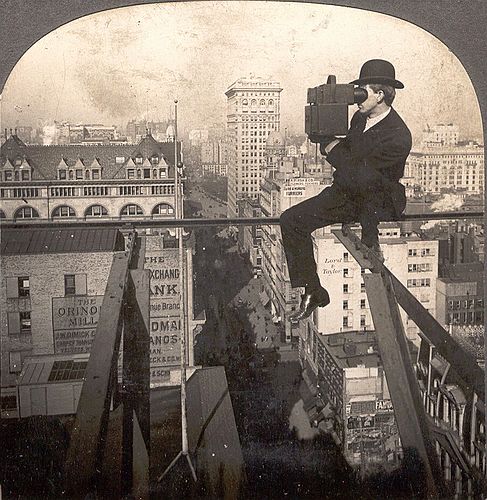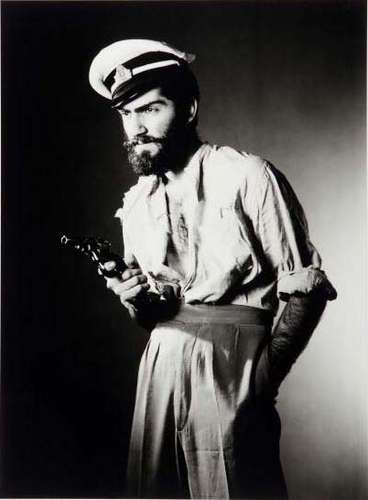| Nov 20, 2011 | People taking photographs: Photographs | | | |
Here are some examples of photographs showing photographers at work.

Keystone View Company
#8288 Looking north up Fifth Ave., past Flatiron Bldg and Madison Sq., New York
n.d.
Stereoview, detail
Jefferson Stereoptics
Courtesy of John Saddy (Auction, Tues. August 29th & Thurs. August 31st, 2006, # 06-3, Lot 752)
LL/13876

PhVTitle | Lightbox | Checklist
Exhibition: People taking photographs: Photographs
| 
| | Nov 20, 2011 | People taking photographs: Illustrations | | | |
I thought it would be useful to bring together examples of illustrations showing photographers at work - risking their well-being with bulls and lions.

PhVTitle | Lightbox | Checklist
Exhibition: People taking photographs: Illustrations
| 
| | Nov 15, 2011 | Gustave Le Gray: Camp de Châlons (1857) | | | |
"L‘empire c‘est la paix," but in the fashion of perfect equipment for the field. France possesses at the present moment two enormous assemblies of troops - one near Lyons, one at Chalons. This double muster would appear to be dictated by two objects, and we can easily divine them. Lyons is a point from which a weight could be brought to bear either upon Spain, upon Switzerland, or upon Italy. The other camp at Chalons offers a ground upon which the empire can develop its military resources to the highest degree of perfection; it is this camp over which the Emperor presides in person, surrounded by the elite of his generals, in Marshals Pelissier, Canrobert, Magnan, and General de Grammont, with many officers of high rank. Marshal Canrobert is the permanent Commander-in-chief. The camp comprises a complete army, with its infantry, cavalry, artillery, engineers, and even commissariat. Since June it has been undergoing thorough training, even in grand manoeuvres. Speaking in laudation of the Chalons Camp, the Moniteur says, that " the most redoubtable armies at the opening of a campaign have always been those familiarized by a long stay under canvass, in time of peace, with the rough exigencies of discipline and fatigue." Napoleon the First liked to have troops trained as armies, habituated to move in organized masses, and his nephew preserves the same strategy. The prime object in rendering the army available for immediate service, has already been attained. "It may now be said," the Moniteur announces, " that the education of the troops is complete, not only in a limited sense, as applied to one branch of the service, but as applied to the whole body of troops acting together on a vast field of operations." Has this camp a further purpose, or has it not?
The Spectator (Oct, 9, 1857)

PhVTitle | Lightbox | Checklist
Exhibition: Gustave Le Gray: Camp de Châlons (1857)
More about this photographer
| 
| | Oct 29, 2011 | African Photography from the Walther Collection at Paris Photo 2011 | | | | The Walther Collection has been invited by Paris Photo 2011 to present highlights from its African photography collection
On view November 10-13 at the Grand Palais in Paris, exhibition of portraiture to be featured in the international fair's spotlight on African artists.
The Walther Collection has been invited by Paris Photo, the world's most renowned art fair for photography, to present highlights from Events of the Self: Portraiture and Social Identity at the Grand Palais, the new location for the fair's 15th edition. Featured as part of Paris Photo's Private Collection series, and coinciding with the fair's celebration of African photography, the exhibition will be on view from November 10-13.
Events of the Self: Portraiture and Social Identity, curated by Okwui Enwezor for The Walther Collection's inaugural exhibition in Neu-Ulm, Germany in 2010, offers an extensive account of modern and contemporary African photography. The exhibition investigates diverse formulations of portraiture, questioning the relation of self-representation and social identity across three generations of African artists and during societal transitions from industrial to postindustrial economy and colonial to postcolonial modernity. Reflecting the changed contexts of photography in showing the structural and cultural transformations reshaping individual and collective subjectivities, the exhibition also incorporates the work of German photographers, establishing a cross-cultural dialogue between African and European pictorial strategies.
The exhibition includes works by Sammy Baloji (DR Congo), Bernd and Hilla Becher (Germany), Allan deSouza (Kenya/USA), Alfred Martin Duggan-Cronin (United Kingdom/South Africa), Rotimi Fani-Kayode (Nigeria/United Kingdom), Samuel Fosso (Cameroon), Pieter Hugo (South Africa), Seydou Keïta (Mali), Hentie van der Merwe (Namibia), Santu Mofokeng (South Africa), Zanele Muholi (South Africa), J. D. 'Okhai Ojeikere (Nigeria), Jo Ractliffe (South Africa), August Sander (Germany), Berni Searle (South Africa), Malick Sidibé (Mali), Guy Tillim (South Africa), and Nontsikelelo (Lolo) Veleko (South Africa).
In addition, collector Artur Walther has been invited to participate in the LIVE PLATFORM series, as contributor to a round table talk on the topic of Emerging regions and boomerang effects on the West. The program seeks to explore the consequences of an increased internationalized exchange between cultures and continents on contemporary artistic practices. The round table will be held Thursday, November 10, at 2:30pm at the Rotonde de la Reine at the Grand Palais.
For more information on Paris Photo, click here.
The Walther Collection
Reichenauerstrasse 21
89233 Neu-Ulm/Burlafingen
+49 731 176 9143
info@walthercollection.com
The Walther Collection Project Space
526 West 26th Street, Suite 718
New York, NY 10001
+1 212 352 0683
contact@walthercollection.com
www.walthercollection.com
|
| | Oct 28, 2011 | Some unusual work on Central Asia coming up at the Neret-Minet Tessier auction | | | |
Neret-Minet Tessier - Photographies - 10 Nov. 2011, 2 o'clock
The auction includes albumen prints from Central Asia by, or attributed to, Dmitri Ermakov [Dmitry Yermakov], Alexander K. Engel and others.
| 
| | Oct 28, 2011 | New Book: The Changing Face of Portrait Photography | | | | Shannon Thomas Perich The Changing Face of Portrait Photography: From Daguerreotype to Digital (Washington, DC: National Museum of American History, 2011) [ISBN-10: 1588342743, ISBN-13: 978-1588342744]
This new book by Shannon Perich, associate curator of the Smithsonian’s Photographic History Collection, examines a series of well known photographers including Juliet Margaret Cameron, Dorothea Lange, Richard Avedon, Gertrude Käsebier, Nicholas Murray, Henry Horenstein, Lauren Greenfield, Robert Weingarten along with the less well known George K. Warren and the Barr & Wright Studio. It is obviously impossible to provide a complete historical analysis of portraiture in this way and the complexity of the contemporary portrait was so admirably covered in William Ewing's book Face: The New Photographic Portrait (Thames & Hudson, 2006) but this is in no way a criticism. This book takes a rather different tack and blends the well known with the less obvious to place them into a cultural, historical and technical framework. This review uses a number of examples to highlight this framework.

George K. Warren, Yearbook Cover, 1859, Album cover, 13 x 11 ins, Courtesy of Smithsonian Books
The works of George K. Warren (1824-1884) are not well known and yet they have considerable significance as they include some of the earliest, if not the earliest, American college yearbooks starting from 1858 and continuing on until his death in 1888. This legacy of yearbooks has a key place in the material culture of American society has long been overlooked and deserves attention.

Barr and Wright Studio, Boy with Photo Album on Lap, 1870s (ca), Wet collodion negative, 5 x 3.5 ins, Courtesy of Smithsonian Books
The Barr & Wright Studio is another brave choice as they are little known but portraiture was the mainstay of most studios and requires attention. The photographs from the 1870s were taken using wet plate collodion and we see the small details of the everyday, the postmortem infant so common the 19th century photography, adults keeping children in place, communion portraits, African American women and all the properties that a fashionable studio was supposed to have - the posing chairs, backgrounds, rustic gates and pedestals to rest on.

Gertrude Käsebier, F. Holland Day, 1907, Platinum print, 8 x 4 ins, Courtesy of Smithsonian Books
I always feel that the portraits of Gertrude Käsebier (1852-1934) have a homely character and that sentimentality places them squarely in the pictorial tradition. A friend of photographer Fred Holland Day the significance of her photographs was appreciated by Alfred Stieglitz who devoted the first issue of Camera Work to her work. In an age when there were few women photographers she excelled but did not alter her style as soft-focus style as Pictorialism waned in significance. Times have not been kind to the Pictorialists and they are widely seen as sentimental but that is a fashion that will change. The significant role of Gertrude Käsebier deserves inclusion in any survey of portraiture.

Richard Avedon, Joe Louis, Fighter, 1963, Gelatin silver print, 19 x 15 ins, Courtesy of Smithsonian Books and the Richard Avedon Foundation
The brutal lens of Richard Avedon is known through his portraits and his talent was recognized in 1962 when the Smithsonian Institution gave him a solo show at a time when photographic exhibitions in major institutions were not as common as they currently are. Avedon's portraits make few, if any, concessions to beauty - the people are seemingly in normal clothes and make-up to enhance was seemingly irrelevant. One of the subheadings in the book is "Substance over Flattery" and that seems spot on - he photographed people significant in the cultural sphere but was able to extract a moment of emotion - confidence and intelligence in the eyes of Linus Pauling, self-concealment through the closed lids of Ezra Pound or the suppressed fortitude within William Casby.

Robert Weingarten, Chuck Close, 2007, Digital image, 44 x 60 ins, Courtesy of Smithsonian Books
Robert Weingarten has explored a deeper aspects of personality with his series Portraits without People which became Portraits Unbound. By combining digital images selected by the subject he created new works that reflect on aspects of the personality rather that the more obvious face. A representation of the subject is no longer necessary although in the portrait of Chuck Close he is included. With Lennard Kleinrock, who was involved with the development of the World Wide Web, his image includes an M.C. Escher drawing representing the illusionary nature of two dimensional reality along with cabling indicative of communications and the formality of a suit and tie. A portrait is here in tangential form.
There will be those who pick up this book and fail to appreciate why certain people have been included but the selection is thought provoking and deserves reflection.
|
| | Oct 28, 2011 | Dawn's Early Light - an exhibition on photography at Cornell University | | | | Dawn's Early Light: The First 50 Years of American Photography
Cornell University Library
Investigating the Dawn of the Photograph
Exhibition Celebrates the Arrival of Thousands of 19th-Century American Photographs
Photography changed the course of history, offering Americans an entirely new view of themselves and their own country.
Now, through an exhibition at Cornell University Library, some of the country’s rarest, earliest and most important photographs will be on display for the world to see.
“Dawn’s Early Light: The First 50 Years of American Photography” features photographs and related artifacts about the technological development of photography — from daguerreotypes to gelatin prints — in the 19th century, while also illuminating the turbulent historic currents that shaped the nation.
The exhibition opened Oct. 20 in the Division of Rare and Manuscript Collection’s Hirshland Exhibition Gallery in Cornell’s Carl A. Kroch Library. The exhibited materials are highlights from a magnificent set of more than 16,000 19th-century American photographs from the Beth and Stephan Loewentheil Family Photographic Collection.
Highlights of the exhibition include: Multiple photographs by preeminent Civil War photographer Mathew Brady, including a large 1861 portrait of Abraham Lincoln, warmly inscribed to the wife of Lincoln's oldest and closest friend; Images documenting the Civil War, including a photograph of American Red Cross founder Clara Barton sitting with soldiers; A personal photograph album compiled by Mark Twain; and Photographs documenting African-American life, westward expansion and the rise of celebrity culture.
“Super-collectors like Stephan Loewentheil have enriched our Library in extraordinary ways,” said Anne R. Kenney, Carl A. Kroch University Librarian. “Without people who are dedicated to collecting and preserving historic artifacts, we would never be able to tell such a rich and complete story about our own history and the milieu from which Cornell was established.”
Its opening celebration is scheduled for Wednesday, Nov. 16 at 4:30 p.m. in Olin Library’s Amit Bhatia Libe Café. Deborah Willis, Chair of the Department of Photography & Imaging at the Tisch School of the Arts at New York University, will deliver a lecture entitled “Framing the 19th Century Photograph: Then and Now,” followed by a reception in the Carl A. Kroch Library. The opening events are funded through the generosity of Gail ’56 and Stephen Rudin.
“This collection from the Loewentheil family stands as one of Cornell Library’s most significant acquisitions,” said Katherine Reagan, curator of Rare Books and Manuscripts. “It provides rich visual documentation that will complement and extend the Library’s major textual collections on 19th-century America. Moving forward, the images in this collection will vastly increase our ability to understand our history.”
The exhibition will run through May 4, and it has been funded by generous support from the Loewentheil Family and the Stephen ’58, MBA ’59 and Evalyn Edwards ’60 Milman Exhibition Fund.
|
| | Oct 23, 2011 | Leaves | | | |
If a negative photograph, or a piece of lace or a leaf, be placed over the prepared paper, and put in sunshine, in a few minutes a perfect impression of the object is obtained. The light darkens the colour of the bichromate, and renders it insoluble in water, while the yellow colour washes out from the parts protected from the light by the lace or leaf, or negative photograph, as the case may be. But pictures of this kind have little or no practical value; for although the lights are good enough, the deep black shadows are only represented by a tawny shade. Some eighteen months ago a process was patented for deepening these photographs by treating them with gallic acid and a salt of iron, which went by the name of ' Sella's process.' I tried this process at the time according to the specification of the patent, but failed to make one satisfactory specimen. They wanted everything that a good photograph should have,—pure lights, clear halftints, and deep shadows,—and as I found that others had not been more successful, I abandoned my experiments.
W. M'Craw, "On a New, Cheap, and Permanent Process in Photography", Twenty-Eighth Meeting of the British Association for the Advancement of Science, Section A - Mathematical and Physical Science, The Athenaeum, No.1618, Oct. 30, 1858, p.554

PhVTitle | Lightbox | Checklist
Exhibition: Nature: Leaves
| 
| | Oct 18, 2011 | Shadows | | | |
What we call "relief "—that is, the apparent standing out of the object from its ground—is effected by the contrasting of light and shadow. So, would you produce breadth and splendour of effect, join together masses of light objects and corresponding masses of dark objects. Again: to get harmony and softness sink some objects wholly or partially in shadow, and let their outlines be insensibly lost in the ground. Finally: to create vivacity and spirit make, in some parts of the picture, abrupt breaks and sharp transitions.
Lights and Shadows in a Picture: Their Use and Value [Root's "Camera and Pencil"] reprinted in The British Journal of Photography, April 9, 1875, Vol.XXII, No.779, p.177.
Related exhibitions on Luminous-Lint:
- Abstraction of the Real
- Solarization
- Distortions
- Photograms
- Multiple exposures - Snapshots
- Above
- Below

PhVTitle | Lightbox | Checklist
Exhibition: Shadows
| 
| Oct 11, 2011
** Ongoing **
Help required | Portraits of photographers | | | |
We are continually seeking to locate portraits of photographers so we can share them with everybody as an aid to research. If you have any portraits of photographers in your collection please email through a scan - alan@luminous-lint.com. All photographs are fully credited and linked back.

Van Leo
Self-portrait of Van Leo
1942, 19 October
Gelatin silver print
Galleria Magenta52
© The American University in Cairo
| 
|
Ongoing • Newest • Newer • Older • Oldest Mode: LL C_NEWS_CF
|

